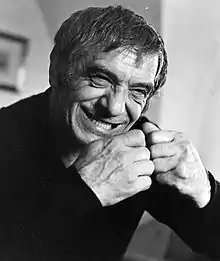Amerigo Tot
Amerigo Tot (born Imre Tóth; 27 September 1909 – 13 December 1984) was a Hungarian sculptor and occasional actor. He was born in Fehérvárcsurgó, Austria-Hungary[1] and moved to Rome, where he lived for the rest of his life. He studied in Budapest under Ferenc Helbing and György Leszkovszky from 1926 until 1928, and at the Bauhaus in Germany. As the Nazis came to power he moved to Rome and worked sculpting memorials on a stipend from the Roman Hungarian Academy, where he eventually became an adviser. He fought in the Italian resistance movement starting in 1943.
Amerigo Tot | |
|---|---|
 Amerigo Tot in 1969. | |
| Born | Imre Tóth 27 September 1909 |
| Died | 13 December 1984 (aged 75) |
| Occupation | actor, sculptor |
| Years active | 1967–1977 |
He first received international recognition for his work on the frieze in Roma Termini station. He began doing abstract works in the 1950s. He returned home to Hungary several times, including 1937, 1939 and in 1969 which was a long prepared step from the side of the Hungarian communist culture-buro. At home he was a highly celebrated "world famous" artist. He had big exhibitions. He did traditional works, including a Madonna sculpture in his hometown, and very famous abstract sculptures, public monuments too, like Microcosm in Macrocosm (a tribute to Béla Bartók), His Majesty, the Kilowatt in Kecskemét. The Amerigo Tot Museum in Budapest is named after him.
In the 1960s and 1970s he made small appearances in films. He is perhaps best known to English-speaking audiences for his role as Bussetta, Michael Corleone's bodyguard and executioner of Johnny Ola in The Godfather Part II.[2][3][4] According to George S. Larke-Walsh, Tot's character in the film had to be brutal so that Michael's authority was retained.[5] He also appeared in The Most Beautiful Wife and Pulp (1972). The latter was directed by Mike Hodges for United Artists and featured Tot as Sotgio.[6]
Tot died in Rome in 1984 and was buried in Farkasréti Cemetery in Budapest.
Filmography
| Year | Title | Role | Notes |
|---|---|---|---|
| 1968 | Listen, Let's Make Love | Baron von Tummler | |
| 1969 | Satyricon | Lica - Trifena's husband | |
| 1970 | The Most Beautiful Wife | Antonino Stella | |
| 1970 | La califfa | Industrialist | |
| 1972 | Pulp | Partisan | |
| 1974 | The Godfather Part II | Michael's Bodyguard | |
| 1976 | Cuore di cane | Il portiere |
Notes and references
- Simon, Andrew L. (1998). Made in Hungary: Hungarian Contributions to Universal Culture. Simon Publications LLC. p. 51. ISBN 978-0-9665734-2-8.
- Lebo, Harlan (25 October 2005). The Godfather Legacy: The Untold Story of the Making of the Classic Godfather Trilogy Featuring Never-Before-Published Production Stills. Simon and Schuster. p. 240. ISBN 978-0-7432-8777-7.
- Santas, Constantine; Wilson, James M.; Colavito, Maria; Djoymi Baker (21 March 2014). The Encyclopedia of Epic Films. Scarecrow Press. p. 236. ISBN 978-0-8108-8248-5.
- Murphy, A.D. (December 9, 1974). "The Godfather, Part II". Variety. Retrieved 2007-07-01.
- Larke-Walsh, George S. (6 April 2010). Screening the Mafia: Masculinity, Ethnicity and Mobsters from The Godfather to The Sopranos. McFarland. p. 241. ISBN 978-0-7864-5613-0.
- Marill, Alvin H. (8 December 2004). Mickey Rooney: His Films, Television Appearances, Radio Work, Stage Shows, and Recordings. McFarland. p. 139. ISBN 978-0-7864-2015-5.
Sources
- - new website by Peter Nemes
- amerigotot.hu - website by Peter Nemes
- - Official Amerigo Tot Museum, Pécs
- - Amerigo Tot memorial room, Budapest
- exhibition in Ludwig Museum Budapest
- Amerigo Tot at IMDb
- Sinkovits P. (1982): Az érintések öröme. (The joy of touch.) Report with Amerigo Tot. Művészet, XXIII, No. 7. p. 10-14. (In Hungarian)
- Nagy Z. (1982): Szemelvények egy életműből. (Section of an ouvre.) Exhibition of Amerigo Tot in Budapest, in the Vigadó Galéria. Művészet, XXIII, No. 7. p. 14-19. (In Hungarian)
